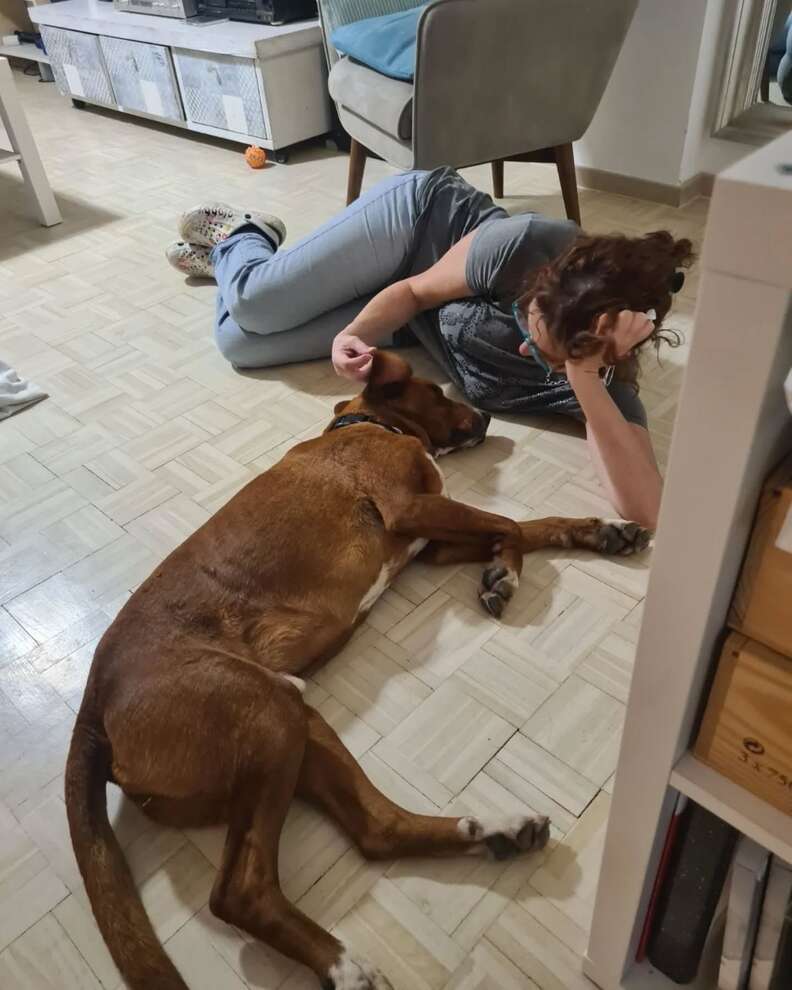The Dog Who Pretended a Statue Could Love Him — Until Someone Showed Him Real Affection.
On a chilly afternoon in late autumn, Vesna Vukojevic was walking down the streets of Trstenik, Serbia, when she caught sight of something that made her stop in her tracks. It was the kind of moment that slices through the noise of everyday life, searing itself into memory with its quiet tragedy.

There, outside a small bakery, sat a stray dog. His ribs were visible under his rough coat, his eyes wide with the weight of loneliness. What made Vesna’s heart ache, however, wasn’t just his condition — it was what he was doing.
The dog had nestled himself against a mechanical statue. Its arm moved back and forth in an endless, predictable rhythm. And this starving, forgotten animal pressed himself against it so that, with every mechanical swing, it brushed across his fur.
For anyone watching, it looked almost as though the dog was being petted.
In reality, it was something far more heartbreaking: a desperate attempt to mimic affection he hadn’t felt in far too long.
Vesna pulled out her phone, recorded the scene, and shared it online. She may not have realized it in that moment, but her short video would circle the globe within hours.

The clip spread like wildfire, striking a deep chord with anyone who saw it.
“That just killed part of me,” one person wrote in response.
“Poor dog just wants to be loved,” another added.
The comments poured in by the thousands, each reflecting the same truth: this wasn’t just a video of a stray. It was a stark reminder of how deeply all living beings crave love — and how unbearable its absence can be.
But among the viewers was someone who couldn’t stop at sadness.
Nina Savić, an animal lover and rescuer based in Belgrade, was more than 200 miles away when she first saw the video. Yet something about that dog pressed against a machine touched her in a way she couldn’t shake. She couldn’t let him remain a symbol of heartbreak on the internet.
With the help of friends, Nina set out to track him down. It wasn’t simple — stray dogs in Serbia are many, and they move constantly in search of scraps. But the town of Trstenik had seen him before, wandering the streets, curling up on corners, waiting by bakery doors for a kind handout.
When Nina and her team finally found him, he was wary. Strays learn caution as a survival skill, and for a dog who had been ignored for so long, trust was something foreign. But patience won out. Bit by bit, they coaxed him into safety.
And just like that, the lonely dog leaning against a statue was no longer alone.

Nina named him Hogar the Horrible, a playful, ironic title that made rescuers laugh — because anyone who met him quickly discovered that his heart was nothing but tender.
Still, Hogar needed time. At first, when human hands reached out to stroke him, he flinched, uncertain. He seemed to wonder: was this real, or just another illusion like the machine’s mechanical arm?
But slowly, as days turned into weeks, he began to change. Blankets replaced cold sidewalks. Gentle voices replaced passing footsteps. A bowl of food waited for him every evening, and loving arms welcomed him every morning.
“Hogar is wonderful,” fellow rescuer Maja Pinter later said. “He loves to be cuddled. He just puts his head in the hands of everyone he meets.”
The dog who once pretended a statue could love him now sought affection eagerly, his eyes softening with the confidence that he finally belonged.

What struck Nina and Maja most was how quickly Hogar adapted to kindness. It was as if the months of loneliness had not hardened him but instead deepened his capacity to love. Everyone who visited Nina’s home found themselves falling for him.
“Everyone is in love with him,” Pinter admitted. “He knows how to win everyone’s heart.”
And Hogar, for his part, seemed determined never to waste a single chance to show affection. He leaned into every hand offered, wagged his tail at every smile, and curled himself into laps with a sense of relief so profound it was almost visible.
For now, Hogar lives with Nina in Belgrade. She has already given him more than he ever dared dream of: safety, warmth, and love. She admits that while she hopes to find him a forever family, she would happily keep him forever herself. After all, she has already been changed by him.
Hogar’s story is no longer just about a lonely stray. It is about the way compassion can rewrite even the most tragic beginnings.
Once, he pressed his frail body against a machine, begging it to act as a substitute for a human hand. Now, he wakes each day surrounded by people who adore him, his once-empty world filled with love.

From the sidewalks of Trstenik to a warm home in Belgrade, Hogar’s journey is a reminder of the resilience of animals — and of the transformative power of simple human kindness.
He will never again have to imagine affection. He will never again be forced to lean on cold metal for comfort. He has found what he was searching for all along: not scraps, not survival, but touch, warmth, and love.
And now, he is no longer just Hogar the Horrible. He is Hogar the Beloved.




